Properly introducing your dog to your baby is an important step towards integrating your family together. Even the most well-behaved and friendly dog can be frazzled by a screaming, crawling, fur-pulling baby or toddler.
Preparing your dog for this shift, managing your dog and baby’s interactions, and eventually teaching dog and baby coping skills will keep everyone happy – and safe.
When I worked at the nation’s fourth largest animal shelter, we received what felt like endless owner-surrendered pets due to dogs and babies not getting along.
In some cases, the dogs were probably simply the wrong fit for a home with a small baby. In other cases, the problems seemed more preventable.
Let’s focus on all aspects of dog-baby introductions: picking the right dog, preparing the dog, and troubleshooting if things go wrong.
How Do I Know If My Dog Will Live Well With A Baby?
There’s no easy way to tell for sure that your dog will do well with a baby. However, there are some good warning signs that a dog will not do well in a home with a baby or small children.
Breed can be a helpful indicator of which dogs do well with babies, but is not a guarantee.
Red Flags: Signs Your Dog Might Not Interact Well With a Baby
If you have a dog that exhibits these characteristics or are looking at adopting one with these characteristics, you should get professional help before introducing your dog and your baby. These “red flag” characteristics include dogs that:
- Use their mouth to play roughly. Some mouthing is ok, but play that is so rough that it leaves red marks is not acceptable for a home with a baby. Keep in mind the rules about what is normal biting behavior for a puppy is different than what’s normal for an adult dog.
- Jump up to greet people. Your toddler will be knocked down. This isn’t a deal-breaker, but you’ll need to work on training!
- Growl around food or toys. A resource-guarding dog can quickly become dangerous for your baby. Read our full guide on dealing with resourcing guarding in dogs for more info.
- Do not tolerate handling well. If your pup quickly becomes evasive, tense, or growly with basic handling such as brushing, nail trims, or tooth checks, she is unlikely to take kindly to a toddler in the home.
- Are easily “spooked” by abrupt sounds, movement, or strange things in their environment. These dogs may not become aggressive towards a baby – though some might. However, dogs that are extremely high-strung and easily stressed might not be best served by staying in a busy home with babies and toddlers.
- Struggle with strangers, guests, or other dogs. It is 100% possible for dogs to dislike other dogs and still do well with toddlers. However, a dog that doesn’t do well with strange people or dogs would not be my first choice if I knew I wanted to grow my family later on. These dogs require extra management, care, and training that can quickly become a lot to handle for a growing family.
This list is not at all exhaustive, but it gives you a good start. Your dog might do well with a baby even if she exhibits some of these behavior concerns. Think of them as little warning signs, but not dealbreakers necessarily. Awareness of any concerns or red flags is the first step towards keeping your baby safe and your family happy.
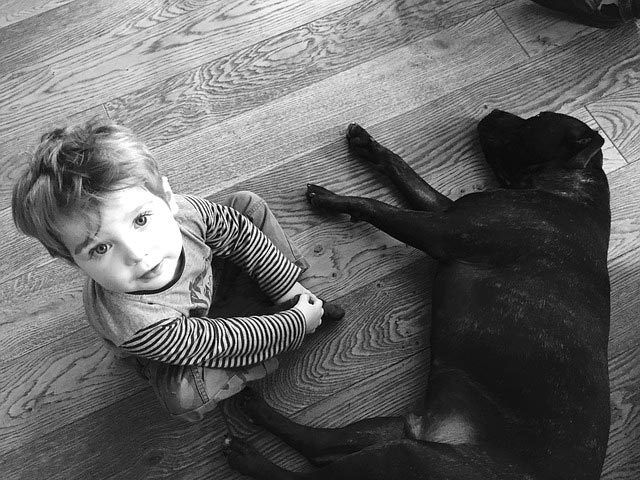
Signs That Your Dog Might Get Along Fine With Babies
On the flip side, there are some really good signs for dogs that are likely to do well with a baby in the home. These signs are not guarantees, but they’re a good omen. When thinking about a dog that will do with a baby, I envision a dog that:
- Is a totally cool cucumber in a variety of situations. Some dogs are just awesome at “rolling with it.” They flop down and take a nap in coffee shops and patiently navigate Christmas parties like professionals. These dogs have the jackpot of genetics, socialization, and training. They’re the ideal dog for a family with a baby or children.
- Has met and done well with lots of children of a variety of ages. Some dogs simply have never met a baby or toddler before. This alone can make the experience of meeting one extra-scary. The loud noises, strange smell, and abrupt movements of babies and toddlers easily throw many dogs off.
If you’re adopting a dog, select one with a proven track record with babies. If you’re going in “blind,” so to speak, it’s time to start introducing your dog to other small children. We’ll discuss how to do this safely later on.
- Can cope well with periods of low exercise. It’s all well and good to have a dog that tolerates, or even enjoys, being around children. However, a dog won’t succeed in a home with a baby if that dog requires constant exercise. Of course, it’s possible to hire a dog walker through apps like Wag and Rover – or get other help with exercising your dog. But with the costs (both financial, emotional, and time) of a new baby, this simply isn’t a financial reality for most families.
- Is very patient with handling, even if it’s rough. It seems like every toddler I’ve ever met goes through a hitting phase where they just love whacking one object with another. Babies learning to walk often grasp at things to pull themselves up. While it’s your responsibility as the adult in the home to protect your dog from a grabby or rough child, it’s also a reality that your dog is likely to get some rough handling from a child. Some dogs simply do better with this than others.
My Border Collie, for example, is amazing with handling if you are gentle, consistent, and confident. I brush his teeth, pull out dreadlocks, and trim his nails with ease. Pull on his tail or surprise him when he’s sleeping, though, and he’s quick to give a warning growl. He is not an ideal dog for being around toddlers because of this.
- Is capable of choosing distance when she’s irritated. Let’s face it – toddlers can be irritating at times, even for their doting parents. Your dog won’t be immune to this, especially since she didn’t choose to have a baby at all. Dogs that do well with babies are often skilled at removing themselves from a situation when they’re getting overwhelmed, rather than sticking around until they snap.
It’s important to give your dog the ability to remove herself from stressful situations, and reward her when she does.
What Can I Do To Help My Dog Prepare For My Baby?
If you already have a dog, you can’t do much to change her personality. Instead, it’s best to work with what you’ve got.
This will mean taking an honest index of things that your dog might struggle with, versus things that she’s likely to do well with.
Once you have a good idea of where your dog’s strengths and weaknesses lie, you can start to build a plan to help your dog prepare for having a little one around the house.
As a general rule, preparing your dog for a baby should include:
1. An exercise and contingency plan
Newborns and toddlers are a ton of work.
Make a family plan for how you’ll keep your dog well-exercised and cared for. This might include a hired walker, trading services with a neighbor, or simply a daily rotation of dog exercise. Don’t forget to have a few numbers of people you can call if you’re really in a pinch.
Exercise is an integral component of your pup’s health. Plenty of trainers will tell you that a large number of dog behavioral problems can be solved with increased exercise. It’s also a great stress reducer and can be good bonding time for you and your canine.
Finally, a tired-out dog is just going to be generally easier to manage around your baby than a dog that’s full of bottled-up energy. So don’t skip on the walks!
Products like flirt poles and classes such as nosework are other great ways to get your pup’s energy out without taking up too much of your time.
2. Stock up on lots of puzzle toys
To be perfectly honest, your dog is likely to fall to the wayside a bit with a new addition to your home. You simply aren’t likely to have the time to give your dog the walks, playtime, and attention that she’s used to.
Puzzle toys, both store-bought and DIY, are an amazing way to combat boredom. Stock up on puzzle toys and boredom-combating ideas so that you can easily tend to your dog’s needs with a baby on your hip.
3. Practice relaxation training
Going through the entirety of Karen Overall’s 15-day relaxation protocol will help teach your dog to be a bit more capable of rolling with the punches.
You also will be able to use her mat training skills to give her a place to lie that’s out of the way while you deal with diapers and other messes.
You might also want to consider an Adaptil diffuser spray or calming treats. These tools can help “take the edge off” of your dog’s stress during this transition time.
The video below shows what day 1 of Karen Overall’s relaxation protocol looks like:
4. Foster positive exposure to children
Please, do not just take your dog to the local daycare and turn her lose to “prepare her for your baby.” This is a recipe for disaster.
Instead, take your pooch for walks near where you’re likely to see small children. Bring some tasty treats and reward her for either calm and relaxed interest, or ignoring the children. Gradually move closer. If you’re in a public space, be sure to coach the parents and children around you not to startle, hug, or grab at your dog.
If you have friends with children, do some staged and controlled practice runs. Ensure that the child is carefully coached on how to feed your dog treats and how not to approach the dog.
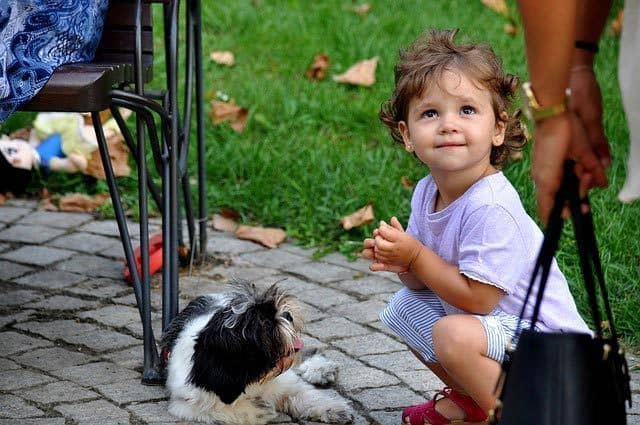
5. A safe space for your dog
Before your baby comes home, set up a little safe haven for your dog. This could be her crate, a mat, or just a corner of the house.
As your baby becomes more mobile, you can coach your baby to leave your dog alone when your dog is there. Once the space is set up, start to reward your dog for choosing to go there. You can also feed her meals in her special space or just practice sending her to the designated spot. This space will be her sacred, safe place where she can just get away from it all.
6. Hire a trainer if you have concerns about fear, reactivity, or aggression
There are great “Dogs and Storks” programs out there where you can learn more about introducing your dog to a baby and find experienced trainers to help. This is a great idea for any dog-loving family that is planning on growing, but is especially important if your dog exhibits and of the “red flags” from above.
7. Exposure to the smells and sounds of babies
Babies smell and sound funny when compared to the rest of your dog’s world. Bringing home baby toys, a slept-in baby blanket, and other objects that smell like babies will help your dog get used to the baby’s presence.
You can do this by borrowing objects from friends or bringing home your newborn’s blanket before your newborn leaves the hospital.
How To Introduce Your Dog To A Baby: Slow and Steady
Ideally, your dog’s first introduction to a baby will be long before you and the little one enter the front door.
Whether this means adopting a dog that is already familiar with babies after your own baby is born or socializing your dog with other babies before your baby arrives, this is important for success.
Newborn Babies
When introducing your dog to a newborn baby, the most important first step is safety. This means that your dog should be, at minimum, on a leash. The little one should be held by another adult.
Set up your dog at a safe distance and have some treats ready. Your dog and baby don’t need to be next to one another to learn about each other. Just having your dog in the room with your newborn as your pooch takes in all the sounds and smells of this brand new little human is a good start.
Your job is to reward your dog for casual, calm interest and choosing to disengage. Keep an eye out for these calming signals to really keep your dog safe and comfortable. Redirect your dog’s focus onto something else if your dog is overly enthusiastic about the baby, as this can be dangerous too.
Slowly allow more interaction, monitoring both the dog and baby for signs of discomfort as well as signs of over-excitement.
Toddler Years
There won’t be much you can teach a newborn about appropriate dog communication, but as your baby grows into a toddler, they should learn what interaction is and is not allowed with your pooch.
Praise the child for gentle, slow movements if the child is old enough. Consider praising the child for choosing not to engage with the dog, as this may help prevent “magnetism.”
As time goes on, you can reward your dog and toss treats away from the toddler (this helps teach your dog to choose space if she’s stressed) when the toddler does things like cry, throw things, roll around, or play with her toys.
The goal isn’t total separation between your dog and your baby, but it is important to help your dog stay farther away when she’s stressed.
This means that you should never let your toddler or baby pull on fur, take toys or food from your dog, hug your dog, pull herself up using the dog, or ride the dog.
The internet is full of YouTube videos of children doing this, and the vast majority of these dogs look extremely stressed out. To an experienced eye, these videos look like a dog bite waiting to happen.
Older Children
As you child gets older, you can take things up a notch. Try playing this dog bite prevention game with slightly older children to help them learn how to read dog body language and response appropriately.
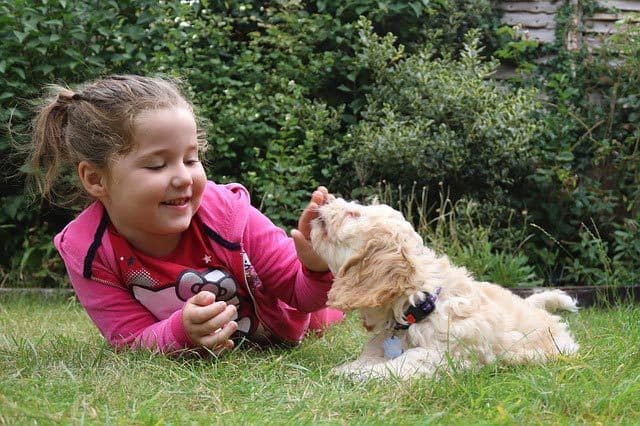
The Bottom Line: Reward Your Dog for Staying Calm
At its core, a dog-child introduction should go slow and steady. The speed of dog-child integrations will vary based on your dog’s comfort level with a baby. Luckily for new parents, introducing a dog to a newborn is relatively easy due to the newborn’s relative helplessness.
Reward your dog for calmly tolerating changes in the baby’s behavior and movement, and keep your dog and baby separate when they’re unsupervised. That’s really it – but this can be easier said than done.
What Can I Do If My Dog Doesn’t Like My Baby?
There are some behavioral problems that are, in the grand scheme of things, generally not that big of a deal. These behavioral problems might include dogs that are totally obsessed with fetch or dogs that have a habit of stealing socks.
Then there are serious behavioral problems. These problems may be dangerous to the dog or family members. Dogs that are aggressive towards babies – even if that aggression is rooted in fear – need help.
If Possible, Hire a Professional Trainer ASAP
If your dog hides from the baby, growls at the baby, or shows other clear signs of discomfort with your baby around, you must hire a reputable dog trainer and be ready for some hard work, or consider rehoming your dog. In my professional opinion, this is non-negotiable. Look at Dogs and Storks or search for certified dog behavior consultants in your area.
I get it. Hiring a professional dog trainer is not cheap, and PetSmart group obedience classes are not going to cut it in this case. However, ignoring your dog’s unfavorable reaction to your baby is not a solution and the problem is not going to go away on its own.
You might be able to get by with a dog who dislikes the cat by splitting your house up. You can navigate a neighborhood full of unfriendly dogs if you’re careful. But it’s nearly impossible to successfully manage a household where the dog and the baby don’t get along without serious professional help.
If you can afford it, hiring a professional, in-home, experienced, and positive-reinforcement based trainer is your best option. Ask your trainer if they adhere to Least Intrusive, Minimally Aversive training methodologies and if they have experience specifically with dogs and babies.
But what if you can’t afford it?
Ultimately, if working with a trainer isn’t an option, then it’s time to seriously consider rehoming your dog.
Rehoming Your Dog: Sometimes, It’s The Only Option (And Best For Everyone)
This is a situation that far too many families face. Please remember that you are not alone, and you are not a failure if your dog and your baby don’t mesh well together. Some dogs are not well-suited to homes with babies, and some babies are more challenging than others.
Giving up your dog does not mean you’re failing her. In some cases, making the decision to find a new home for your dog is actually better for your dog than keeping her in your home. Try to be honest with yourself about, and ask these three questions:
- What does my dog’s perfect life look like?
- What does the perfect dog for my family look like?
- How does my dog’s life and my dog’s personality compare to these ideals?
Let’s look at a past client of mine as an example – Charlie.
Charlie was a big, bright-eyed, flat coated retriever. He loved guests so much that he’d jump on them, pulling at their clothes with his claws. He was big, and it hurt. Charlie stole toys and didn’t give them back, and he barked. He barked a lot.
Charlie’s parents called me when they were at the end of their ropes because Charlie was starting to knock their son over, steal his toys, and bark constantly during their son’s naptime. The baby was getting no sleep and was starting to be scared of Charlie.
Charlie’s family decided that Charlie’s ideal life included a lot of exercise, playtime with his best friends, a structured relaxation time, and a backyard.
They looked at their own lives and told me that their ideal dog was friendly, playful, and big enough to keep the wife of the family safe on walks.
Based on Charlie’s progress in our training sessions plus his increasing maturity, we decided that Charlie was still a good fit for their home.
Ultimately, Charlie’s behavior concerns were not very dangerous for the home. The family increased his exercise regimen, we taught Charlie how to trade stolen toys for treats, and we taught him to quietly lay on his mat instead of barking during nap times.
Charlie’s parents had flexible work schedules that allowed them to exercise Charlie several times per day. They also had the financial ability to pay for a dog behavior consultant to help with their goals. Charlie stayed in his home.
Now let’s edit a few details to Charlie’s story and see how the results change. We’ll call this new dog Marley. Now, Marley growls when people take toys away from him, and his owners work full-time jobs instead of working from home. They don’t have the time or money to hire a trainer, a dog walker, or just exercise Marley more on their own.
Does Marley absolutely need to go to a new home? No, probably not. But this situation is different. It’s harder to weigh out whether or not Marley is best served by staying in this home.
Additionally, it is probably dangerous for a child to interact with Marley if he is likely to growl when the child tries to take toys (and don’t forget that for dogs, puppy toys and little human toys can look pretty similar). Marley is a bite risk for a child in this home.
It’s always best to look at your options long before your dog bites a child. Don’t wait until the situation is dangerous.
If I were called by Marley’s owners, I would ask some hard questions about whether or not Marley would truly be happiest in this home. If the parents cannot exercise the dog at all, is the dog happy? If the parents attempt to manage Marley’s toy theft and growling by simply leaving him in a crate for 23 hours per day, is that what’s best for Marley?
In our Marley scenario, it’s important to look at both the safety of the child and Marley’s well-being.
If you feel that keeping your dog in your home is not safe for your baby or best for your dog, it’s time to start looking at other options. My favorite option is to find a trusted friend or family member who can take a pet. This is what I did in the past when my life changed dramatically and I needed a new home for my parakeet. If this is not an option, reach out to local rescue groups and shelters to see what options might be available.
Some communities have financial aid-assisted programs that partner with trainers to keep dogs in homes, or local rescues might be able to help match your dog with a new home without your dog ever setting foot in a shelter.
Before relinquishing your pet to a public shelter or no-kill shelter, ask what happens to dogs that are not quickly adopted and what policies are in place. If you want more information on finding an appropriate place to relinquish your pet, read this article on deciding when it’s time to rehome your dog.
Prevention is the best, as always. If possible, start out with a dog that has a solid temperament in order to successfully pair a dog to your growing family.
If you already have a dog, take steps to prepare her for a baby’s arrival with planning, training, and socialization. Keep monitoring your dog and baby’s interactions, and redirect both parties when needed.
How did you introduce your dog to your baby? What tools, training protocols, or tips were most valuable?

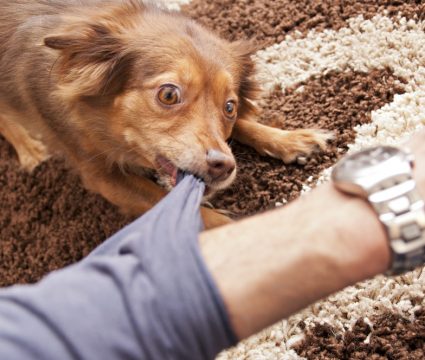



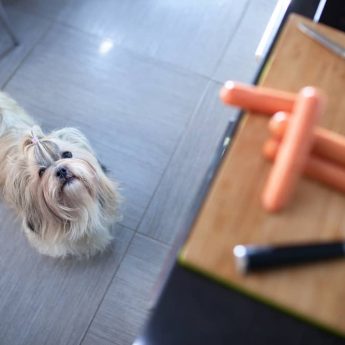


2 Comments
June 4, 2021
Kayla,
This a great article and we will be beginning another round of professional training on Monday. In the meantime I was hoping you could elaborate on the hiding and growling, what it means and why he is exhibiting this behavior. He has positive newborn interactions as a puppy and he’s been ok with other peoples toddlers, but he seems to take exception to my baby.
Could it indeed be jealousy?
-Nick
June 4, 2021
Hey there, Nick. Sorry about the challenges with your pooch!
Kayla may not have time to respond here (she stays pretty busy training!), but you can reach out to her at Journey Dog Training.
Best of luck!